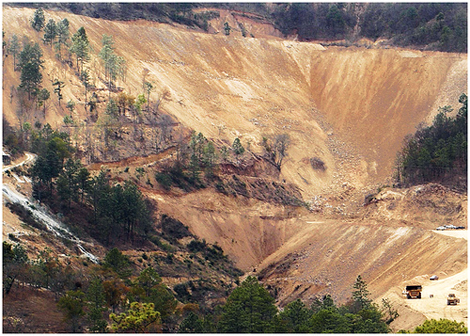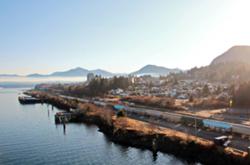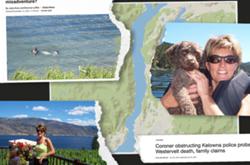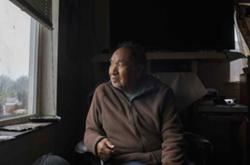
From the vantage point of the city square, it's impossible to tell that San Miguel Ixtahuacán is at the centre of Guatemala's mining boom. A couple of vendors sell chicken, fries and pop, but most of the stands are empty, many of the businesses are closed and broken windows dot the municipal hall.
Just 20 kilometres away by dirt roads lies the Marlin project, "one of the first modern mining investments in Guatemala in years," according to Goldcorp Inc., the Vancouver-based company that owns the mine. Previously owned by Glamis Gold, and now property of Goldcorp, the Marlin project is a precedent-setting gold mining project in Guatemala.
Goldcorp is the third largest gold producer in North America, with properties in Honduras, Guatemala, Mexico, the U.S. and Australia. Goldcorp's fully owned subsidiary Montana Exploradora is leading the pack of companies cashing in on the mining boom that has swept across Guatemala since the mining code was changed to favour foreign direct investment in 1997.
Guatemala's appeal to global mining interests has much to do with the fact that here royalties from mineral extraction are only one per cent, shared between the state and the affected municipality. A project the size of the Marlin project operating in Canada would be subject to a royalty fee of 13 per cent of total production.
In addition to royalties, the Marlin project today means a couple hundred jobs in the region and Goldcorp has plans to greatly expand what is already a $298 million Cdn operation.
But a backlash has set in against the project. Local residents have voted overwhelmingly against expansion, and say indigenous farmers were left in the dark about the business dealings transforming their region. A protester against the mine was killed by military police while helping to blockade a road. And a recently released report of toxic runoff only bolsters the view of community leaders who say the project hasn't delivered the benefits, economic and otherwise, that would earn support for the big next push.
Open pit where villages stood
After completion of the exploration phase in San Miguel Ixtahuacán in the late 1990s, Goldcorp's predecessors began buying properties from small landholders, paying between eight and 80 times market value for the land they acquired. Over the last two years, these lands have begun to undergo a radical transformation from villages to an open pit mine, which will eventually grow to encompass five square kilometres.
The greater municipality of San Miguel Ixtahuacán has a population of 39,000, comprising 19 villages. The vast majority of people are indigenous peasant farmers, who depend principally on subsistence agriculture for their livelihoods, growing crops of corn, beans, vegetables and fruits, nurtured by irrigation from the Cuilco River and its tributaries.
"The map of mining interests, the map of indigenous people and the map of poverty all line up perfectly. Where there is mining, there is poverty and indigenous people," explains Marco Venicio Lopez Maldonado, who works with the Peasant Workers' Movement (MTC) in the provincial capital of San Marcos. This certainly holds true in San Miguel Ixtahuacán, which is one of the poorest municipalities in Guatemala, where over 70 per cent of people live in extreme poverty.
Edwin Oswaldo Avila Perez, the current mayor of San Miguel Ixtahuacán, told The Tyee that when the mining exploitation started in San Miguel Ixtahuacán, "almost the entire population was uninformed. They didn't know what agreements had already been signed between the muncipal government at the time, the people who sold their lands, the Federal government and the company."
The World Bank, which supported the Marlin project with a $45 million US loan through their private sector branch known as the International Finance Corporation (IFC), claims that the project followed the protocol of the International Labour Organization's Convention 169 (ILO 169), which guarantees the right of indigenous people to exercise control over the form of development that occurs in their traditional territory.
Avila Perez, however, maintains that with relation to the Marlin Project, "Agreements were signed at an internal level, and the population at large was unaware."
'Owners for 5,000 years'
In the adjacent municipality of Sipacapa, the story of the Marlin project has a different character. Some installations of the project already exist on the periphery of the municipality, and the company is currently slated to expand exploration and exploitation into Sipacapa.
Upon getting wind of the Marlin project, community leaders in Sipacapa began to organize a referendum (consulta), a process stemming from municipal law and ILO 169, which allows community members to vote for or against projects on their land. Turnout was high -- nearly half of all registered voters -- for a referendum held on June 18, 2005. In all, voters from 11 of 13 communities in Sipacapa voted unanimously against mining activities in their land.
According to Mario Tema, a community leader in Sipacapa, the process of the referendum has allowed people a legal basis to reject mining in their lands, "revindicating the rights of people who have been the owners of these territories for at least the last 5,000 years."
More than a year and a half has gone by since the referendum took place in Sipacapa, and community members continue to await confirmation from the constitutional court that the results of the referendum will provide them with enough legal backing to keep mining out of their municipality.
In an e-mail interview with The Tyee, Jeff Wilhoit, VP of investor relations at Goldcorp, pointed out that "President [Oscar] Berger has observed that Goldcorp is the single largest taxpayer ever in Guatemala." With such large financial interests opposed to its outcome, legal recognition of the referendum is far from guaranteed.
Wilhoit explains the company's position by stating that "two rulings by the courts at that time ruled the referendums to be unconstitutional. Those rulings are still in place. Goldcorp's perspective is that we will abide by the rule of law as defined by the courts and governmental bodies in Guatemala."
$150,000 'gift' from Goldcorp
In a 2005 report commissioned by the World Gold Council -- of which Goldcorp is a member -- author Jill Leyland stated that major mining companies "are committed to working with the local community and carrying out extensive consultations from development onwards."
But despite the referendum results, Goldcorp continues to employ various strategies to enter into Sipacapa, including offering to pay individual landholders to drill exploration perforations in their land, as well as presenting the municipality with a "gift" of over $150,000 Cdn. Neither offer has thus far been accepted.
Regardless of whether the company agrees to abide by its results or not, the referendum has also been an instrument of consciousness raising, whereby people have become more informed about the costs and benefits of mining megaprojects. Community members have also begun to articulate a comprehensive alternative development plan, presenting concrete possibilities for development that do not rely on mining.
The development priorities outlined by grassroots groups in Sipacapa give a priority to reactivating the agricultural sector, namely by providing technical assistance and training to growers and cultivators, while seeking out new markets for the wide variety of organic products that grow in the region.
Payments into pavement
According to Mayor Avila Perez, local citizens see very little tangible reward from the royalties Goldcorp is paying. Last year, he says, "directly from royalties, we have not invested anything in community projects," but, he continued, "all of the $670,000 Cdn that we have accrued in royalties will eventually be used in paving projects in San Miguel."
Many people living in the area question the benefits that paving will bring, while many people's basic needs go unsatisfied.
Roberto Marani, who is in charge of the Catholic church in Sipacapa, noted that "for peasant farmers, paved roads will only cause pain in the feet of their horses."
One community activist in San Miguel Ixtahuacán, wishing to stay anonymous because of repeated threats of violence from workers at the mine, told The Tyee, "We want the mining company to pull out, because they have not fulfilled their promises to build a hospital, renovate a sports complex, fix up the central park or pave the roads." Many local residents echoed his concerns that the company has not kept its promises to the community.
While a number of small infrastructure projects have been carried out by the company, many people feel that their contribution to the local economy has not been what is should be. Earlier this month, people who sold their lands to the company protested by erecting a road blockade for two weeks. Father Eric Gruloos, who has worked in San Miguel Ixtahuacán for more than 15 years, commented that the people on the blockades felt that they had been "tricked" by the company.
Migration, pollution and threats
During its operational phase, expected to last another nine years, the Marlin project provides 200 jobs, 160 of which are held by local people. In an area with more than 40,000 inhabitants, 200 jobs is a drop in the bucket. Though the World Bank claims that "since construction of the mine started...migration from [San Miguel] to the coast (to work on sugar and coffee plantations) has virtually stopped," the reality on the ground is different.
Maria Lopez, a citizen of San Miguel Ixtahuacán, whose husband is currently working on a plantation, said that this claim that people are no longer migrating to find work is "a lie." She continued to explain that "right now, everyone who can is looking for work in the plantations. Some people are working at the mine, but only the few who have an education, those who aren't educated go to the coast, and many go the U.S."
Fear of contamination is another major concern for residents living in the area, particularly due to the use of cyanide in extracting gold from rock. An independent hydrological study released in November indicates that downriver from the mine, heavy metals are beginning to accumulate, and levels of copper, aluminium and manganese are already over the limits prescribed by the World Bank.
Flaviano Bianchini, the author of the study, has received continuous threats since its publication, and last week Amnesty International began an international campaign to draw attention to concerns for his safety.
Looking north
As the people of Sipacapa continue to resist mineral exploration in the lands, and the citizens of San Miguel work to pressure the company to fulfil their promises, mining at the Marlin project continues. Already more than 105,800 troy ounces of gold, currently valued at over $760 Cdn per ounce, have been extracted.
Goldcorp officials glowingly describe the Marlin project as "a highly prospective land package of approximately 100,000 hectares that encompasses the main Marlin deposit and other important mineralized zones."
But further expansion is likely to be met with more resistance by locals. Many communities are organizing referendums to pre-empt mining activities in their territories, and people are getting better educated about the trade-offs that mining projects bring.
Organizing to force change in mining practices is something that Canadians can work on too, says Lopez Maldonado from the MTC. "Canadians need to start looking at where their pensions are, what their companies are up to, and what the diplomatic corps are doing." His voice is not the only one calling for change, as evidenced by the recent Canadian Roundtables on the Extractive Industries, which concluded last November in Montreal.
Guatemalan journalist Luis Solano doesn't mince words in aiming advice far north of his own border. "Denouncing these companies," he says, "is the first step for Canadians to take."
Related Tyee stories:
- Mining Gold, and Outrage, in Guatemala
- Tahltan Resistance to Mining, Drilling Grows
- Framing Global Capitalism














Tyee Commenting Guidelines
Comments that violate guidelines risk being deleted, and violations may result in a temporary or permanent user ban. Maintain the spirit of good conversation to stay in the discussion.
*Please note The Tyee is not a forum for spreading misinformation about COVID-19, denying its existence or minimizing its risk to public health.
Do:
Do not: